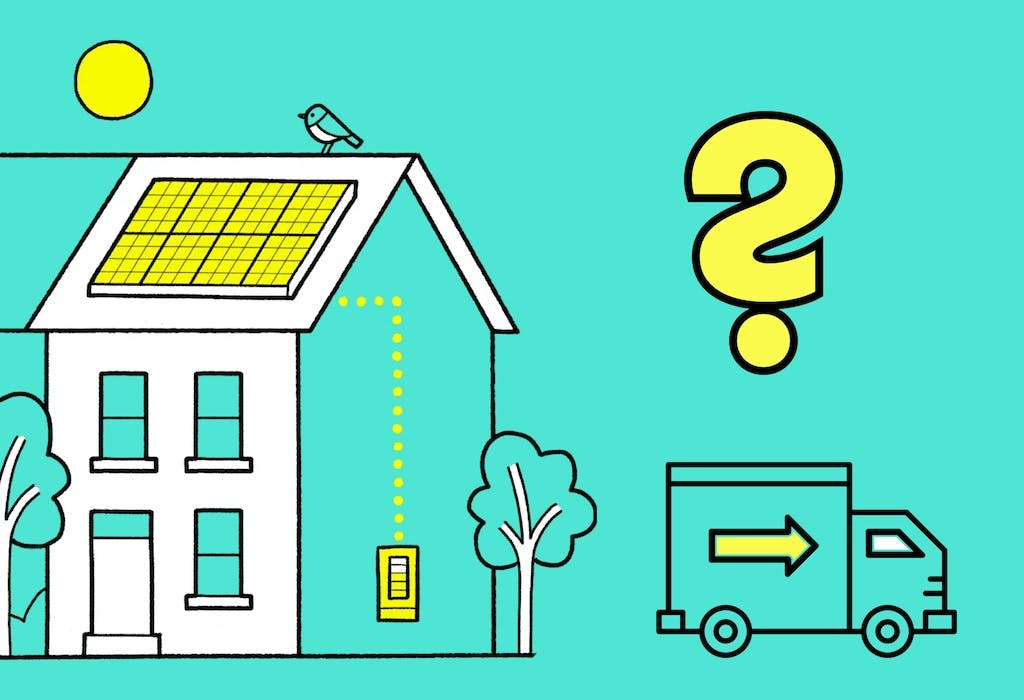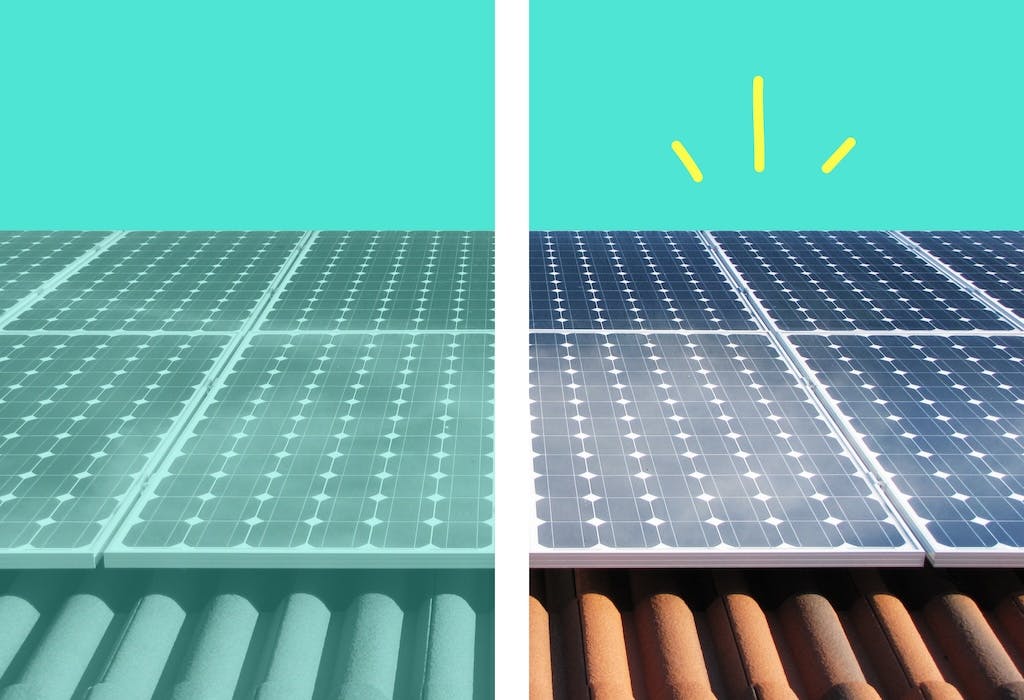- Solar advice hub
- Sunsave-plus
- A guide to your Sunsave Plus proposal
A guide to your Sunsave Plus proposal
Explore our detailed breakdown of the Sunsave Plus proposal, so you can understand every section in detail.


Why you can trust our content
We know that the solar industry is full of misinformation, but we only use reliable sources, including:
- Our experienced solar experts, installers and system designers
- Our own database of solar & battery system designs
- Authoritative bodies like MCS and the UK government



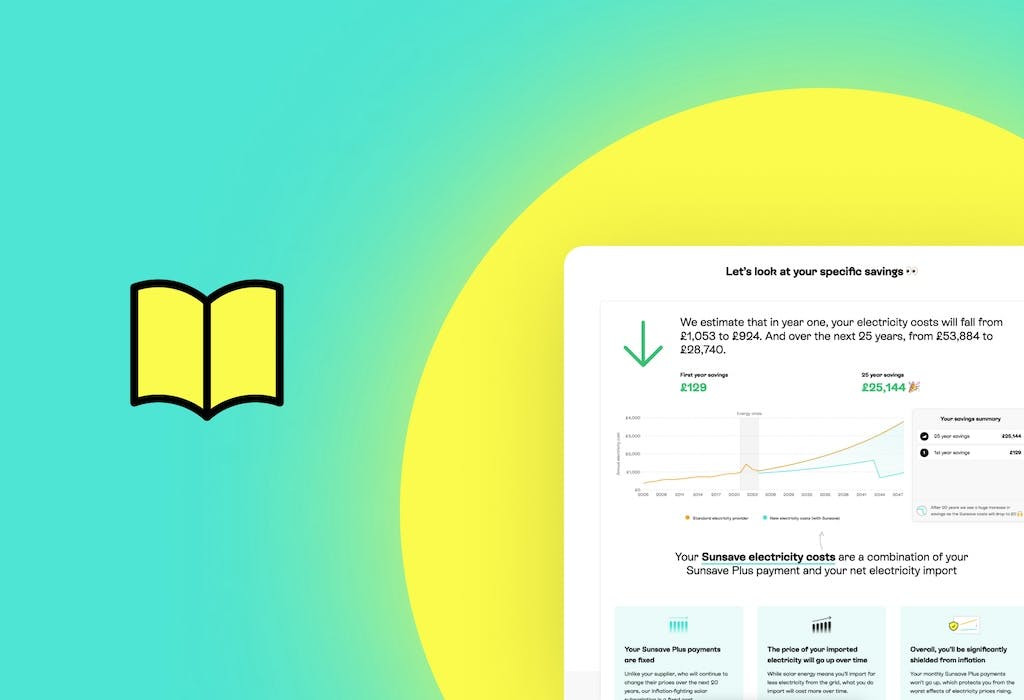
Calculate savings
What kind of home do you live in?
Calculate savings
What kind of home do you live in?
If you’re currently considering the switch to solar power, you’re probably encountering lots of new concepts and technical jargon. Suddenly having to hear about kilowatt-hours, inverters, export tariffs and DC cabling can be pretty overwhelming.
We’ve built our proposal in order to make your solar transition as easy and as informative as possible, so that you know exactly what you’re getting and how much you can expect to save.
In this article, we’ll run through the key parts of your Sunsave Plus proposal and explore them in a bit more detail.
What is your Sunsave proposal?
Part of our Consumer Duty as an FCA-regulated firm is to make sure our customers fully understand what they're buying, as well as all the associated costs, benefits and risks.
One of the ways we do this is by providing full and transparent information throughout the customer journey, which includes the proposal you receive.
Your Sunsave proposal is a detailed summary of the solar & battery system we’d install at your property, including a long-term forecast of how much electricity it will produce, how much money it will save you, and how much it will cost.
The methodology for our generation and savings estimates has been validated by an independent third party called the Energy Performance Validation Scheme (EPVS). Our gold membership with EPVS means we’re held to the highest possible standards.
To learn more, check out the guide to our accreditations and why they matter.
Now let's run through your Sunsave Plus proposal. Here are the sections we'll cover:
- Monthly cost and price breakdown
- What's included
- Savings estimates
- System performance
- Cost and savings breakdown
- Full calculation breakdown
Monthly cost and price breakdown
Our price summary should show you four important figures:
- your monthly cost
- your total credit amount
- the APR
- your £0 deposit
Your Sunsave Plus payments consist of three key elements: the principal, the interest, and the monitoring & maintenance fee.
The monthly payment remains fixed throughout the 20-year subscription term, so it acts as protection against electricity price inflation (more on that further down).
What’s included
This first part of the proposal runs through exactly what your monthly price includes, so you’re clear about what you’re paying for.
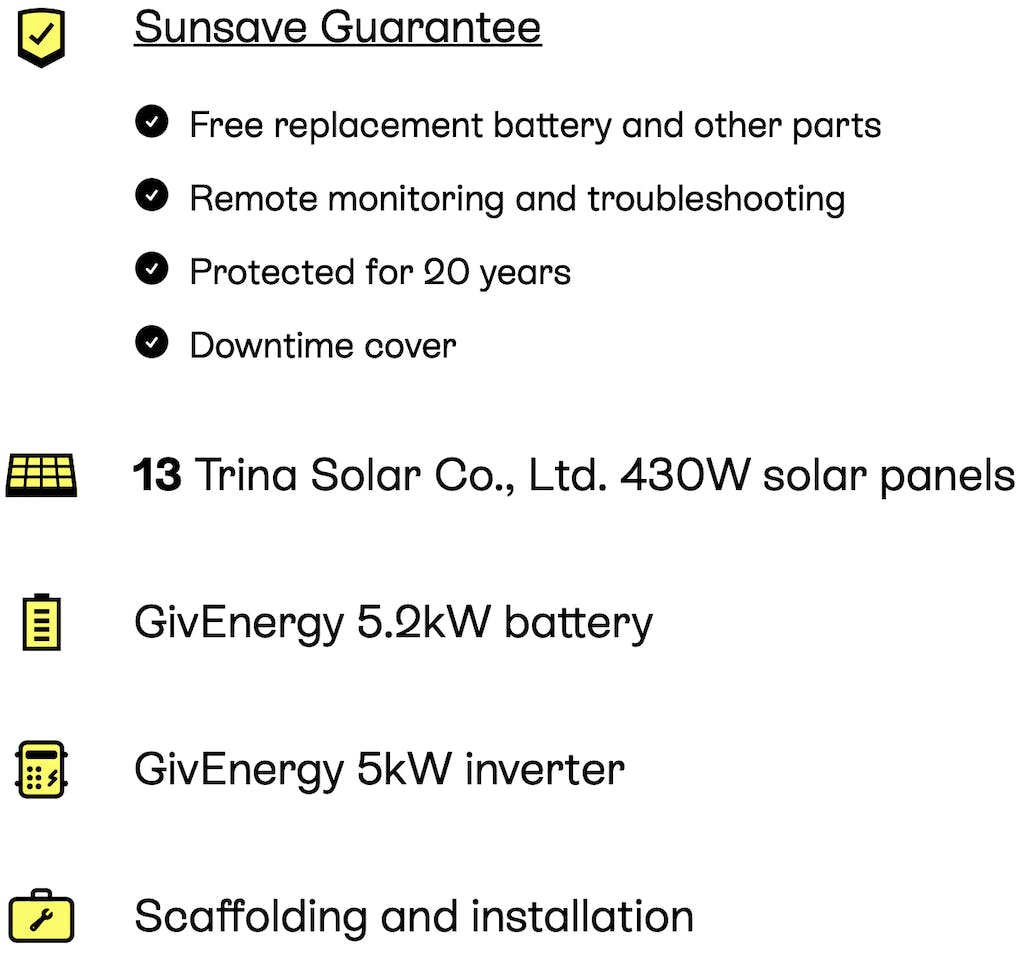
The Sunsave Guarantee
Your solar & battery system will be backed by the Sunsave Guarantee.
In an industry where companies often leave customers stranded post-installation, the Sunsave Guarantee is a monitoring and maintenance package designed to give you peace of mind. You can rest assured that your system is going to produce a steady flow of clean, green electricity for the full 20-year term of your subscription.
To find out more, check out our guide to the Sunsave Guarantee.
Solar panels
We’ll specify the type of solar panel that we’d like to install on your roof. At Sunsave, we always use black, monocrystalline solar panels, which are much more powerful and efficient than blue, polycrystalline solar panels.
The number followed by a ‘W’ is the wattage of the solar panel, and this tells you how much electricity the solar panel can produce. For example, ten 430W solar panels equates to 4,300W or 4.3 kilowatts-peak (kWp), which means the system is capable of producing 4,300 kilowatt-hours (kWh) of electricity per year in standard test conditions.
For more information, you can scroll down to the ‘Your kit’ section of the proposal, which also includes a link to the solar panel’s datasheet. This is where you can find lots of technical information about the solar panel, such as its dimensions, efficiency rating, and degradation rate.
Battery
We’ll also specify the type of battery that we’d like to install at your property. A battery means that you can store up the excess electricity that your solar panels generate, ready for use whenever the sun isn’t shining. To learn more about how they work, check out our complete guide to solar batteries.
All of the batteries we install at Sunsave are top of the range and use lithium ion chemistry, so they last longer and function much more safely than lead acid batteries.
The number followed by ‘kWh’ is the capacity of the battery, and this tells you how much electricity it can store. Generally speaking, a 5-6kWh battery is appropriate for most UK households, unless your annual electricity consumption is very high (i.e. greater than 6,000kWh).
To learn more, scroll down to the ‘Your kit’ section of the proposal. If you want additional technical information, you can check out your battery’s datasheet.
Inverter
Perhaps the most crucial part of your solar & battery system is the inverter, which has the job of converting all the electricity your panels generate from direct current (DC) to alternating current (AC). Without an inverter, your system wouldn’t be very useful.
The number followed by ‘kW’ is the size of the inverter, and this refers to the maximum amount of power that can be processed at any given moment. We’ll always make sure your inverter is slightly smaller than your solar panel system, as every inverter has a minimum startup voltage that it needs in order to work. If your inverter is too large, it runs the risk of not having enough power to operate effectively (especially on winter days).
If the inverter in your proposal is larger than 3.68kW, this means you’ll need permission from your local District Network Operator (DNO) before you can begin to export electricity to the grid. But don’t worry, we’ll handle the application for you.
And whilst we wait for a response, we’ll remotely limit your inverter to 3.68kW. This means you’ll still be able to start generating and exporting electricity, just not to the full extent that your system is capable of.
Once again, if you want to know more information about your inverter, head down to the ‘Your kit’ section of the proposal and click on ‘View datasheet’.
Scaffolding and installation
A chunk of your total price will go towards the cost of erecting scaffolding at your property, which is necessary for us to get the solar panels onto your roof as safely as possible.
Similarly, your quote also includes the cost of actually installing the solar panels. Our installers all comply with the highest industry standards, and are certified by either Flexi-Orb or the Microgeneration Certification Scheme (MCS).
This also means your solar & battery system will be accredited by Flexi-Orb or MCS, which is essential if you want to sign up for any export tariffs and get paid for any electricity you send to the grid.
Savings estimates
This is probably the most important part of your proposal, as it tells you how much money you can expect to save during the first 20 years of having your system.
As previously mentioned, all of our generation and savings estimates are checked and verified by an independent third party called the Energy Performance Validation Scheme (EPVS). Our gold membership with EPVS means we’re held to the highest possible standards.
Your long term energy bill
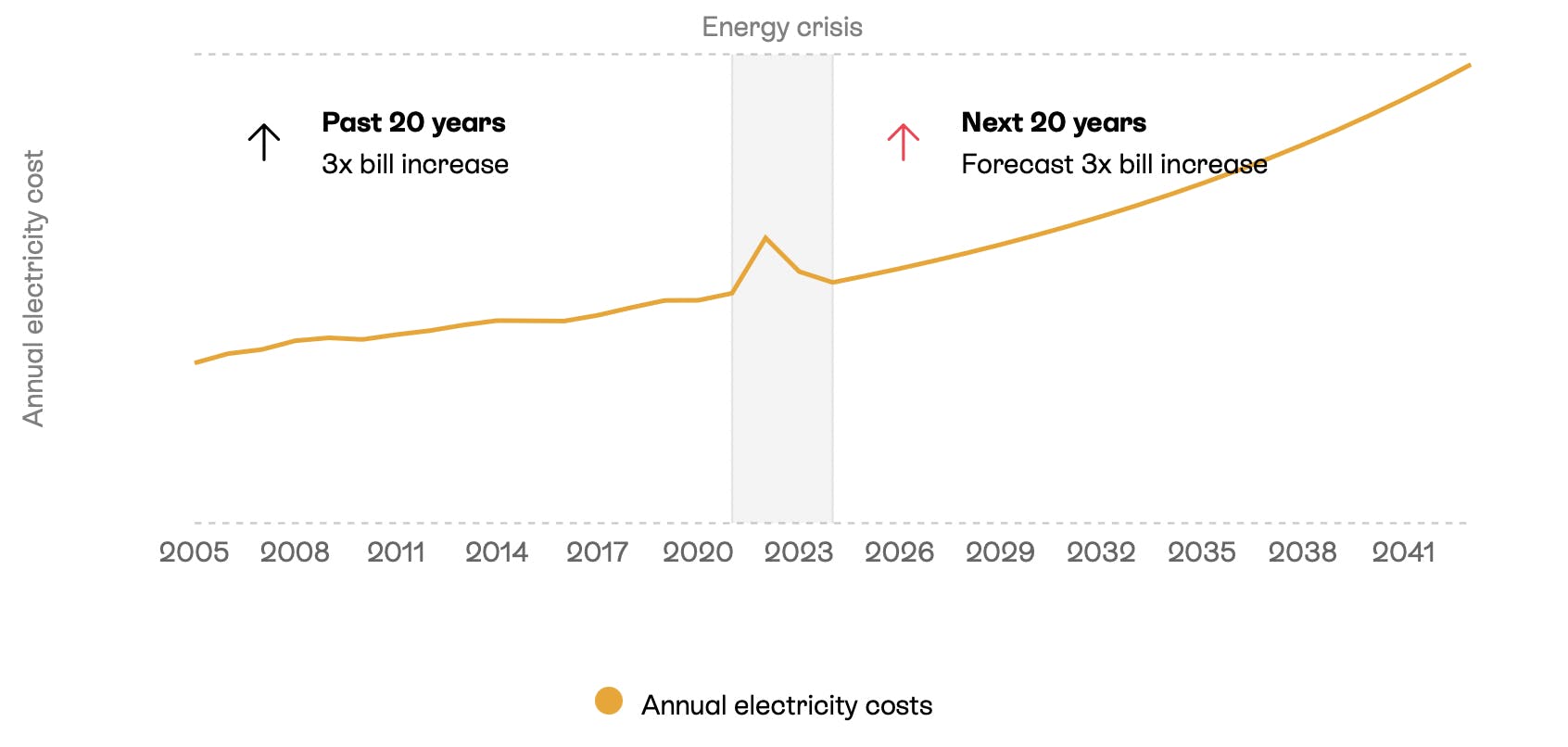
The first graph in the ‘Savings estimates’ section shows what could happen to your energy bill over the next 20 years, assuming you continue to rely on grid electricity and don’t switch to solar. The average annual growth rate of UK electricity prices between 2000 and 2021 was 5.5%, and it’s likely that this growth rate will continue over the next two decades.
This rise was caused by underlying inflation more than it was by shifts in wholesale prices, which suggests that even if wholesale price levels remain stable or drop in the future, the cost of your energy is still likely to grow.
Another reason why energy prices might continue to climb is the ever-increasing demand for electricity in the UK (driven by electric vehicles and heat pumps), which is forecast to grow by 50% between 2020 and 2035.
Energy market analysts Cornwall Insight also expects UK energy bills to remain high until at least the late 2030s.
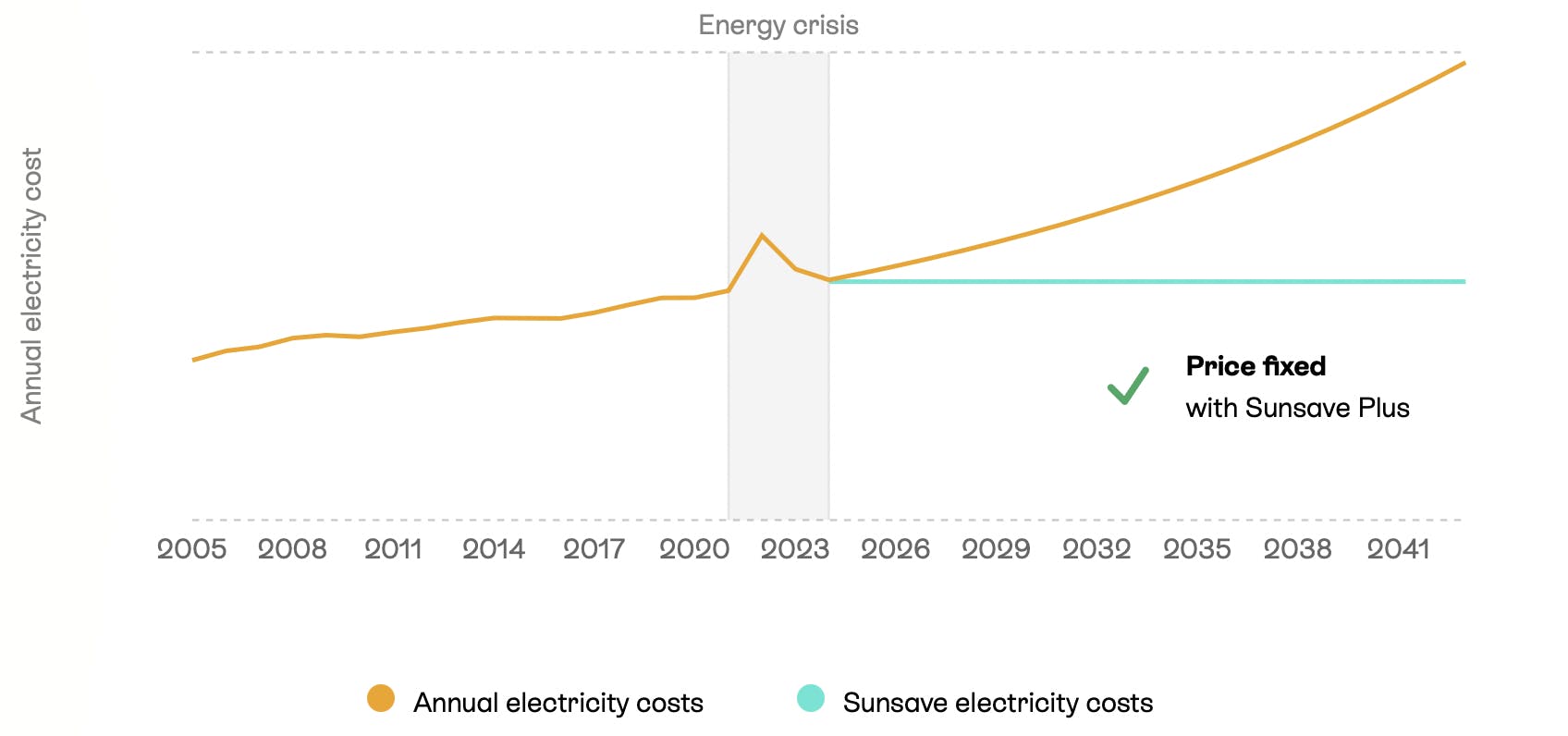
The second graph shows the same long-term rise in energy bills, but also has a straight blue line to represent the fixed cost of Sunsave Plus. As your Sunsave Plus payments remain the same throughout the full subscription term, this means you’re protecting yourself against energy bill inflation.
Your new electricity costs
In this bigger chart, we show you your new electricity costs (with Sunsave) alongside your long term electricity costs (without Sunsave). It’s a handy way of visualising the difference, and demonstrates how the value of Sunsave Plus increases over time. You can hover over the graph to get more information about what each part shows.

The reason your energy bill still increases slightly over time with Sunsave Plus is because you’ll still need to import a small portion of your electricity from the grid (more information about this in the next section).
The chart shows that, as time passes, the gap between these two numbers will widen, which means that the amount you’re saving on your electricity bills increases each year. The gap widens sharply at the 20-year mark, which is when you will finish making your payments for Sunsave Plus. After this point, the savings you’ll make from your solar & battery system will be much larger.
The green area between the blue and orange lines represents your cumulative 25-year savings, which is also displayed as a number in a box to the right of this chart. If your Sunsave Plus system is going to give you 1st-year savings, this number will also be shown in the same box.
Why do you still import some electricity?
In the breakdown beneath the big graph, you’ll see that you’re still expected to import some electricity from the grid each year. This is because it’s unlikely that your solar panel system will make you fully independent from the grid all year round.
Even if the annual output from your solar panels exceeds your average annual electricity usage, it won’t be distributed in a way that actually matches your usage. Generally speaking, about 40% of the electricity a solar panel produces in the UK is generated in summer, with the other 60% split across spring, autumn and winter.
This means that you still need electricity from the grid in certain months - particularly during the winter season. The ‘System performance’ section slightly further down your proposal will tell you more.
Why do you receive export earnings?
You’ll notice in your ‘Electricity cost breakdown’ that it also mentions ‘Electricity exported’.
When your solar panels produce more electricity than your household needs, it will go into your battery - but if your battery is full, the electricity will be exported to the grid, and you’ll get paid for it.
The majority of your exports will happen in the summer, as that’s when your solar panels will typically produce much more electricity than your household and battery can handle. Exporting can still happen in the winter months, but it’s usually only for one or two hours in the middle of the day.
However, another way you might export electricity is through ‘battery tariff optimisation’. This involves charging the battery on the off-peak rate overnight (from either your solar array or the grid), and discharging it during the peak window between 4-7pm (either to your property or the grid). This kind of battery optimisation is managed remotely by the tariff provider, and is only possible on certain tariffs, such as Intelligent Octopus Flux.
Once your installation is complete, you can sign up for any solar export tariff, although the highest-paying tariffs require you to become a customer first. This is usually a quick and easy process, and is well worth it if you want to benefit from the best rates.
System performance
This chart shows you the quantity of electricity you can expect your solar panels to generate in the first year, compared to your annual electricity usage.
As you can see, your system’s generation peaks in the summer months, when the days are longest, the sun is highest in the sky, and clear skies are most likely. Meanwhile, your system produces the smallest amount of electricity in the winter months.
In contrast, your electricity consumption is highest in the winter and lowest in the summer.
This is why you’ll do most of your exporting in the summer, and why you’ll still need to import some electricity from the grid in the winter.
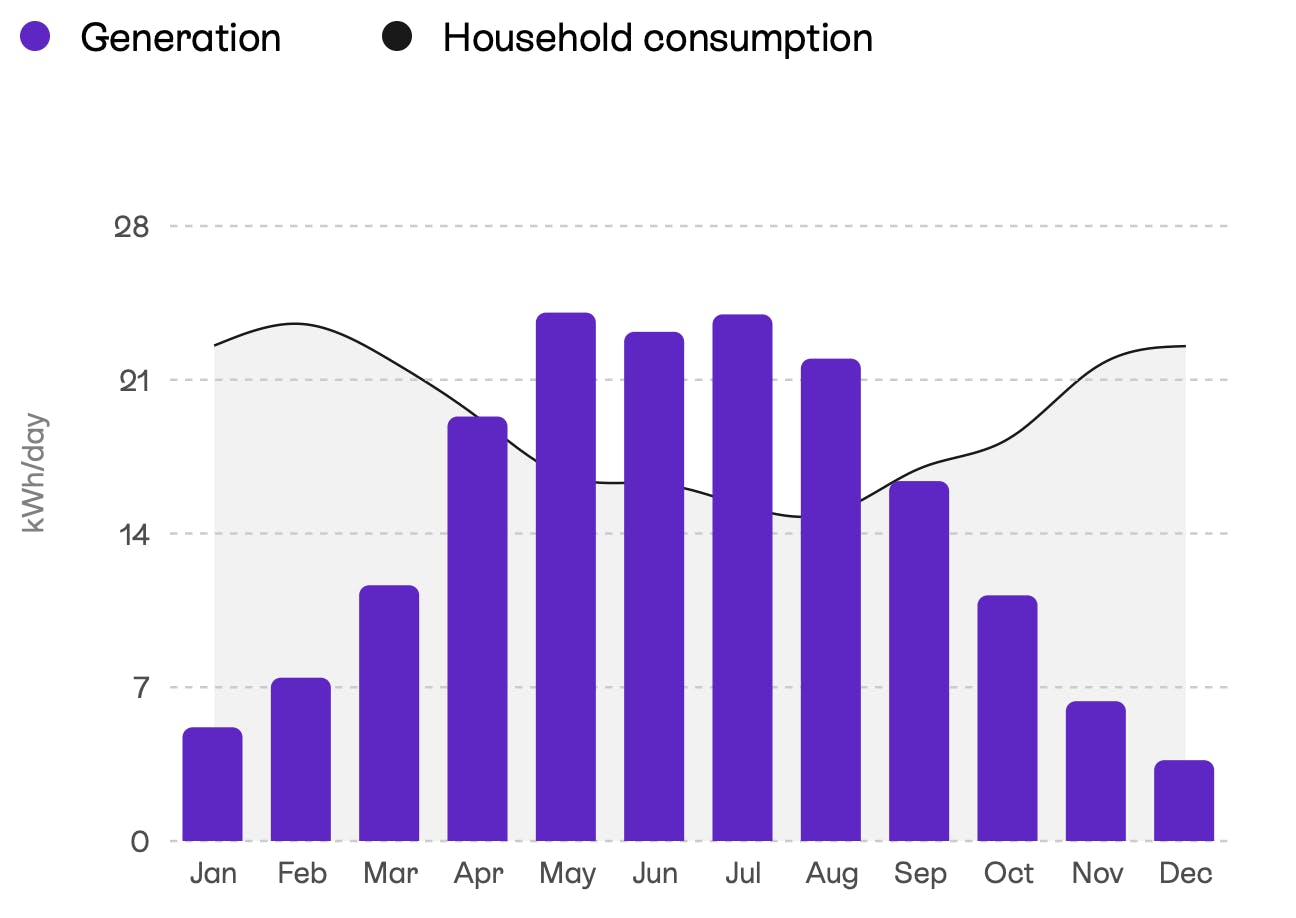
Cost and savings breakdown
This section displays our savings estimates in much more detail, so you can see what’s happening year by year.
You’ll notice that your solar generation decreases slightly each year due to the natural degradation of solar panels, but this is entirely normal. To find out more, check out our guide to how long solar panels last.
All of our solar panels come with a 30-year performance warranty, meaning if they fall below a certain level of output throughout this period, you will be able to get your panels replaced. What’s more, as part of the Sunsave Guarantee, we will continually monitor your system and make sure it’s working properly.
And despite this slight fall in output, your savings will still increase each year due to energy bill inflation.
You’ll also see that after 20 years your ‘annual cost to Sunsave’ falls to £0, which is naturally when your ‘Net savings’ increase dramatically.
Beneath, you can find a full explanation of all the assumptions we’ve made when calculating your savings.
Full calculation breakdown
Finally, our full calculation breakdown explains how we’ve estimated the output of your system.
Installation data
The table starts by telling you the kilowatts-peak of your system, which refers to the amount of electricity it could produce in standard test conditions. For example, if your system is 4.3 kilowatts-peak, this means it is capable of producing 4,300 kilowatt-hours of electricity each year in standard test conditions.
However, the UK rarely experiences standard test conditions, which is what the rest of this section goes on to explain.
You’ll notice that your solar panels have been put into ‘groups’. Your system may just have one group, or it could have several. A group essentially refers to a bunch of solar panels that have been wired together, known in technical terms as a ‘string’.
It’s usually not possible to fit more than about 10 panels on one string, before having to create a new one. Most solar panel inverters can usually deal with up to three or four strings feeding into it.
Even if your solar panels can all fit onto one string, it’s sometimes a good idea to separate them into smaller strings. This is because every solar panel on one string should ideally be aligned when it comes to angle, orientation, and shading - if there’s significant variance within the string, this can reduce output.
The orientation of the system refers to what direction your system is facing, and is expressed in ‘degrees from South’. A perfectly south-facing system (i.e. zero degrees) is optimal, but any variance from this will still be effective - providing it’s not completely north-facing.
The tilt of the system is also expressed in degrees (this time ‘degrees from horizontal’), and will almost always be the same angle as your roof. Around 35 degrees is ideal, but some variance from this is fine.
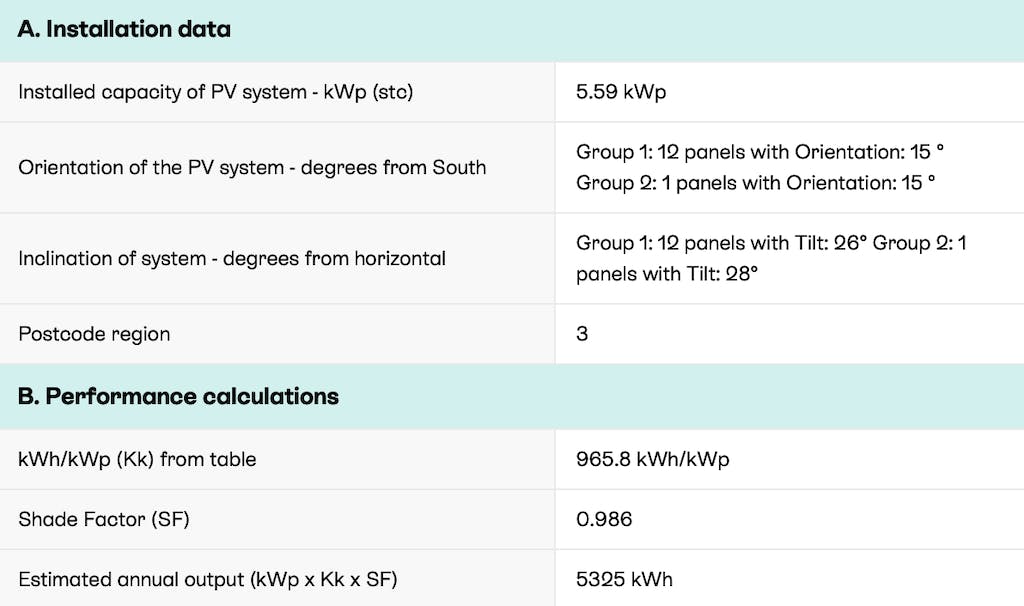
Performance calculations
This part of the table explains how we calculate the expected annual output of your system.
Taking into account the orientation and tilt of each group of solar panels, as well as your specific location in the UK, we refer to the solar irradiance table produced by the MCS.
This table tells us the potential quantity of electricity that a solar panel could produce on your roof, based on the amount of sunshine your property receives. The figure is expressed in terms of kilowatt-hours divided by kilowatts-peak (kWh/kWp), or Kk.
For example, if your first group of solar panels has a Kk of 976, this means a solar PV system on your roof could produce 976kWh of electricity for every 1kWp of capacity.
Once we have this figure, we then apply the shade factor. This refers to the percentage of your rooftop that isn’t experiencing any shade, and is expressed as a number out of 1. For example, if 5% of your rooftop experiences shade, your shade factor would be 0.95.
The final step is to combine your system’s size (kWp), its potential based on solar irradiance, and its shade factor, which brings us to an estimate of its annual electricity production. In the vast majority of cases, this final figure (expressed in kilowatt-hours) is lower than your system’s full potential because the UK does not experience perfectly sunny days all year round.
However, this discrepancy is almost universal across solar panel systems in the UK, and is not a problem. The important thing to focus on is whether the system’s estimated output comes close to (or exceeds) your annual electricity usage.
Estimated PV self-consumption
The final part of the table goes into a bit of detail about how much of your solar-generated electricity you will use directly (known as ‘self-consumption’), as opposed to sending it to the grid. It also shows how this quantity changes based on whether you add a battery to your system (also known as an electricity energy storage device, or EESS).
We determine your level of self-consumption by considering how much time you spend in your property each day. Our default assumption is that you’re in for half of each day, but we will amend this if you’ve told us otherwise.
If you sign up for a solar export tariff that pays you the same rate for exports as you pay for imports (e.g. like Intelligent Octopus Flux), your level of self-consumption doesn’t actually matter. This is because you’ll be getting the same financial benefit from each kWh of electricity that your panels produce, regardless of whether you use it yourself or export it.
However, if you’re not planning on signing up for Intelligent Octopus Flux, it makes sense to maximise self-consumption. As you can see, adding a battery can increase your self-consumption quite significantly.
Summary
If any part of your Sunsave proposal still isn’t making sense, please do get back in touch with us so we can explain it in more detail. We appreciate that the solar industry is full of new concepts and technical language, and it’s important you understand your proposal before proceeding.
If you’d like to continue with Sunsave but haven’t yet done a remote survey with one of our solar experts, this is your next step. The remote survey is free, and involves a simple video call which allows us to determine the specifics of your solar & battery installation. You can book the survey through the button on the proposal, or send us an email.
Alternatively, if you’d rather upload photos in your own time, you can do this in your account.
Related articles

Written byCharlie Clissitt
Born in Yorkshire and now living in London, Charlie has been in the renewable energy industry since 2017, having worked as a writer and then editor of green technology advisor The Eco Experts. His work has focussed on educating UK homeowners about a wide range of residential power and heating solutions, including solar panels, storage batteries, heat pumps, infrared panels, and EV chargers.

